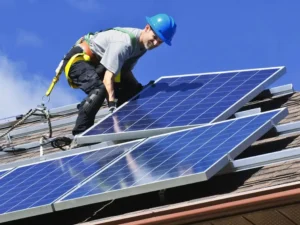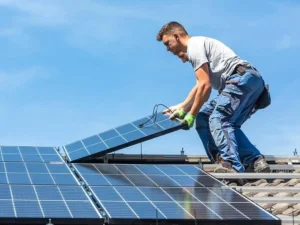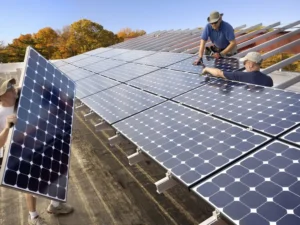Solar power’s popularity in the US has skyrocketed during the last decade. The major reason being the increased awareness about the importance of renewable energy sources. Also, people are now familiar with the threats of climate change. Despite this the major barrier to the rapid installation of solar energy systems in the initial outlay. Therefore, homeowners often want to know how much does it cost to install solar panels.
Factors Affecting the Cost of Solar Panel Installation

The average cost of home solar panels installation in the US can vary depending on the following several factors:
Location
A major aspect that might determine how much it costs to put solar panels on a house is its location. Specifically, areas with high levels of sunshine generally have lower costs for solar panels. This is because the more sunlight a solar panel receives, the more energy it can generate. It means that fewer solar panels are required to meet the same energy needs.
Size of the Solar Panel System
The size of the solar panel system is another significant factor that can affect the cost. Installing a bigger system will cost more. The size of the solar panel system needed is determined by a number of variables, like:
- Energy needs of the home
- Amount of sunlight available
- Solar panel type
Type of Solar Panels

The solar panel installation cost may also vary with the brand you choose. Costing between $1-1.50 per Watt, monocrystalline solar panels are the most cost-effective and finest solar panels for your home. Polycrystalline solar panels, on the other hand, cost $0.90-1 per Watt yet produce far less power. Whereas, the price per Watt for thin-film solar panels is about $1.50.
Installation Costs
Installing anything might be expensive, depending on how much work has to be done. Factors that can affect the installation costs include:
- Type of roof
- Location of the solar panel system
- Electrical system requirements
Average Cost of Solar Panel Installation
The average cost of solar panel installation in the US is around $3.05 per watt, according to the National Renewable Energy Laboratory (NREL). Furthermore, the cost of installing a 6-kilowatt solar panel system, which is the average size for a residential system, can range from $12,000 to $18,000.
State-Specific Costs
The table shows the average cost for an 18-kW solar panel system in each state. The second column shows the cost of grid electricity. The third column provides the estimated net savings over 25 years (assuming a 5% annual increase in electricity prices):
| State | Average Cost for 18-kW System | Cost of Grid Electricity | Net Savings over 25 Years |
| Alabama | $31,320 | $0.116/kWh | $54,562 |
| Alaska | $50,040 | $0.215/kWh | $91,167 |
| Arizona | $24,804 | $0.126/kWh | $75,905 |
| Arkansas | $29,484 | $0.094/kWh | $71,702 |
| California | $28,404 | $0.206/kWh | $97,928 |
| Colorado | $27,180 | $0.129/kWh | $66,491 |
| Connecticut | $31,752 | $0.220/kWh | $90,394 |
| Delaware | $26,244 | $0.202/kWh | $80,198 |
| Florida | $24,732 | $0.113/kWh | $59,031 |
| Georgia | $26,892 | $0.108/kWh | $67,426 |
| Hawaii | $44,964 | $0.321/kWh | $165,783 |
| Idaho | $28,044 | $0.091/kWh | $62,652 |
| Illinois | $26,868 | $0.131/kWh | $64,397 |
| Indiana | $25,572 | $0.116/kWh | $60,421 |
| Iowa | $26,292 | $0.117/kWh | $61,697 |
| Kansas | $25,812 | $0.115/kWh | $60,756 |
| Kentucky | $27,348 | $0.104/kWh | $68,002 |
| Louisiana | $28,608 | $0.095/kWh | $70,016 |
| Maine | $30,732 | $0.175/kWh | $84,285 |
| Maryland | $26,796 | $0.153/kWh | $75,450 |
| Massachusetts | $30,660 | $0.222/kWh | $97,111 |
| Michigan | $27,540 | $0.137/kWh | $66,966 |
| Minnesota | $26,916 | $0.130/kWh | $64,316 |
| Mississippi | $31,476 | $0.108/kWh | $70,259 |
| Missouri | $25,872 | $0.105/kWh | $65,437 |
| Montana | $28,080 | $0.100/kWh | $68,567 |
| Nebraska | $26,292 | $0.105/kWh | $65,338 |
| Nevada | $26,340 | $0.120/kWh | $71,278 |
| New Hampshire | $31,752 | $0.199/kWh | $83,290 |
| New Jersey | $28,836 | $0.172/kWh | $82,143 |
| New Mexico | $24,612 | $0.121/kWh | $71,155 |
| New York | $30,132 | $0.193/kWh | $89,040 |
| North Carolina | $25,824 | $0.107/kWh | $67,803 |
| North Dakota | $29,064 | $0.101/kWh | $69,263 |
| Ohio | $25,992 | $0.110/kWh | $68,444 |
| Oklahoma | $28,044 | $0.086/kWh | $74,086 |
| Oregon | $29,484 | $0.115/kWh | $73,463 |
| Pennsylvania | $26,052 | $0.129/kWh | $63,607 |
| Rhode Island | $30,672 | $0.231/kWh | $93,251 |
| South Carolina | $27,864 | $0.116/kWh | $69,509 |
| South Dakota | $27,252 | $0.114/kWh | $68,044 |
| Tennessee | $26,952 | $0.104/kWh | $65,565 |
| Texas | $25,128 | $0.116/kWh | $62,977 |
| Utah | $26,064 | $0.103/kWh | $64,946 |
| Vermont | $31,320 | $0.191/kWh | $82,219 |
| Virginia | $26,652 | $0.106/kWh | $66,296 |
| Washington | $29,520 | $0.098/kWh | $76,353 |
| West Virginia | $29,568 | $0.105/kWh | $73,287 |
| Wisconsin | $26,952 | $0.143/kWh | $68,539 |
| Wyoming | $28,968 | $0.113/kWh | $70,748 |
Incentives and Rebates

Source: Wikimedia commons
There are several incentives and rebates available for solar panel installation in the USA at the federal, state, and local levels. Here are some of the most significant incentives and rebates for solar panel installation in the USA:
Federal Investment Tax Credit (ITC)
The federal government offers a 26% ITC for residential and commercial solar installations. As a result, homeowners and businesses can deduct 26% of the cost of their solar panel system from their federal taxes. However, starting in 2023, the ITC will step down to 22% for commercial systems and expire for residential systems.”
State and Local Incentives
Many states and local governments offer incentives to promote the use of solar energy. Examples of these incentives are:
- Rebates
- Performance-based incentives
- Tax credits
However, these incentives vary by state and locality, so it’s important to research the incentives available in your area. For instance, California offers the California Solar Initiative. It provides cash incentives for solar panel installations. Whereas, Massachusetts offers the Solar Massachusetts Renewable Target (SMART) program. The SMART program provides financial incentives based on the energy produced by the system.
Net Metering
Net metering is a policy that lets homeowners and businesses sell extra solar energy back to the grid. In return they earn credits on their electricity bills. Each state and utility company has different policies, so it’s important to research them in your area to find out how much money you can save.
Property Tax Exemptions
Some states offer property tax exemptions for solar panel systems. Such exemptions can significantly lower the overall cost of solar. For example, New York offers a 15-year property tax exemption for solar panel installations.
Sales Tax Exemptions
Some states offer sales tax exemptions for solar panel systems, which can lower the upfront cost of solar. For example, Florida offers a sales tax exemption for residential solar panel systems.
Federal and State Grants
Certain government programs offer money to help pay for installing solar panels. These programs are especially for non-profit organizations, schools, and government agencies. One example is the Rural Energy for America Program (REAP) from the Department of Agriculture. It gives grants for renewable energy projects in rural places.
Utility Rebates
Some utility companies offer rebates for solar panel installations, which can help lower the overall cost of solar. These rebates vary by utility company. They may have specific requirements. Such requirements include the type of solar panel system installed or the size of the system.
How Can I Pay for Solar Panels?
Installing solar panels on your home or business can be a significant investment. However, there are several ways to pay for solar that can make it more affordable. Here are some of the most common ways:
Cash
Paying for solar panels upfront with cash is the most straightforward method. If you have the funds available, this may be the most cost-effective option. This is because you will avoid paying interest associated with financing. Paying cash also means you’ll own the system outright. You can enjoy the lower energy bills and potential tax credits right away.
Solar Loans
Many lenders offer specialized loans for solar panel installations. These loans typically have low-interest rates and longer repayment terms. Thus, they make it more affordable to finance a solar installation. Some lenders also offer financing programs that allow you to pay back the loan using the electricity bill savings. Therefore, you may not have to pay any money out of pocket. Check with your local bank or credit union to see if they offer solar loans. Also, look for solar financing companies that specialize in solar installations.
Leases
With a solar lease, you pay a monthly fee to a solar company in exchange for using the solar panels they own and maintain on your property. Leasing may have lower upfront costs than purchasing a system outright. Also, the solar company typically covers maintenance and repairs. However, you won’t be eligible for any tax credits or incentives, and you won’t own the system outright. Additionally, solar leases typically have long-term contracts. Therefore, be sure to carefully read and understand the terms before signing.
Power Purchase Agreements (PPAs)
With a PPA, a solar company installs solar panels on your property and sells you the energy they generate at a fixed rate over a set period. This can be a good option if you don’t have the upfront capital to purchase a system, and you can typically save money on your electricity bills. However, like leasing, you won’t own the system and won’t be eligible for tax credits or incentives.
Property Assessed Clean Energy (PACE) Financing
PACE financing is a type of financing that allows you to pay for solar panel installations through property tax assessments. It is a good option for homeowners who want to avoid taking out a traditional loan or don’t have the cash upfront for solar. However, not all states offer PACE financing, and the interest rates may be higher than traditional financing.
Take Away
The cost of installing solar panels in the US can vary depending on several factors. These include the location of the property, the size of the system, and the type of solar panels. While the initial cost may be high, there are several government incentives and rebates available. With the cost continuing to decrease, solar energy is becoming an increasingly attractive option. It is rapidly getting popular in homeowners and businesses looking to reduce their energy costs and carbon footprint.

